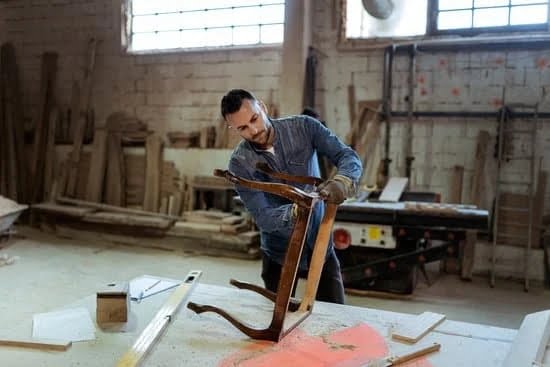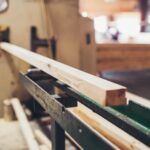Woodworking planes are essential tools for any woodworker. They are used to shape, smooth, and finish wooden surfaces with precision and accuracy. But before engaging in any woodworking project, it is crucial to be able to identify the different types of planes and understand their functionality.
Identifying a woodworking plane goes beyond simply recognizing its general appearance. It involves examining its key features and understanding its anatomy. This knowledge not only aids in selecting the right plane for a specific task but also contributes to the overall craftsmanship of the project.
In this article, we will delve into the importance of identifying woodworking planes in woodworking projects. We will explore how these tools function and their significant role in shaping wood surfaces. Additionally, we will provide a comprehensive overview of the various types of planes available in the market today.
Understanding the importance of identifying woodworking planes is crucial for both beginners and experienced woodworkers alike. Whether you are restoring vintage tools or starting a new project from scratch, this knowledge will enhance your abilities as a craftsman. So let’s dive into the world of woodworking planes and unlock their potential in creating exquisite wooden masterpieces.
The Functionality of Woodworking Planes
Woodworking planes are essential tools in the craft of woodworking. These hand tools have been used for centuries and play a crucial role in shaping, smoothing, and finishing wood surfaces. Understanding the functionality of woodworking planes is vital for any woodworking enthusiast or craftsman.
One of the primary functions of woodworking planes is to remove excess material from a wood surface. This process is known as planing, and it helps create flat, smooth, and even surfaces. Planes are especially useful when working with rough lumber or when you need to reduce the thickness of a piece of wood.
Another important function of woodworking planes is to create chamfers and bevels on the edges of wood. This helps give a finished and decorative look to furniture pieces or other wooden objects. By adjusting the depth and angle of the plane blade, craftsmen can easily achieve desired shapes and profiles.
In addition to these main functions, woodworking planes also serve purposes such as jointing edges for gluing boards together, leveling wooden panels, or making rabbets and grooves for joinery. They are versatile tools that can be used for various tasks depending on their design and configuration.
Common Types of Woodworking Planes
There are several different types of woodworking planes available, each designed for specific tasks. Some common types include:
- Jack plane: A versatile plane that can be used for rough stock removal, flattening surfaces, and leveling timber.
- Smoothing plane: Used after roughing out with a jack plane to produce a fine finish on wood surfaces.
- Block plane: Small-sized planes that are ideal for detail work or end-grain grain cutting.
- Shoulder plane: Designed specifically for creating precise joints like tenons or dadoes.
- Router plane: Used primarily for leveling the bottoms of recesses like grooves or dadoes.
Understanding the functionality of these different types of woodworking planes will help you choose the right tool for your specific woodworking projects. Whether you are a beginner or an experienced woodworker, having a variety of planes in your toolkit will greatly enhance your craftsmanship.
Different Types of Woodworking Planes
Woodworking planes come in various types, each designed for specific woodworking tasks. In this section, we will provide a comprehensive overview of the different types of woodworking planes commonly used by craftsmen.
Bench Planes
Bench planes are the most commonly used woodworking planes and are essential tools in any woodworker’s workshop. They are typically used for flattening, smoothing, and dimensioning wood surfaces. The bench plane family includes the jack plane, jointer plane, smoothing plane, and the try plane. The jack plane is a versatile tool that is used for removing rough stock or making preliminary cuts.
The jointer plane is longer in size and is primarily used for flattening edges or faces of boards to create straight lines. Smoothing planes are smaller in size and are utilized for fine finishing work on smooth surfaces. Finally, the try plane is a larger version of the smoothing plane and is mainly employed in woodworking tasks that require precision with long strokes.
Moulding Planes
Moulding planes are specifically designed to create decorative moldings on wooden surfaces. They come in various profiles or shapes depending on the desired design outcome. Moulding planes typically have a cutting edge on one side and an adjustable fence or guide on the other side to maintain consistent depth and spacing along the woodwork piece. These planes were commonly used during traditional construction and architectural projects to add intricate designs such as beads, fillets, ogees, coves, or chamfers.
Router Planes
Router planes resemble bench planes but serve a distinct purpose – creating consistent depths for mortises (rectangular holes) or recesses within wooden surfaces. They allow craftsmen to precisely control depth by adjusting the blade’s position relative to the sole of the plane. Router planes are highly versatile instruments that can be used for a range of fine adjustments when fitting joints for furniture or other woodworking projects.
By understanding the different types of woodworking planes and their specific functions, craftsmen can select the appropriate tool for each task, leading to more efficient and precise woodworking projects. Whether you are flattening surfaces, creating intricate moldings, or fitting joints, having a comprehensive knowledge of the various types of planes is essential for achieving high-quality craftsmanship.
Key Features and Anatomy of a Woodworking Plane
Understanding the key features and anatomy of a woodworking plane is crucial in identifying and using this essential tool in woodworking projects. By familiarizing yourself with its essential components, you can better understand its functionality and make informed decisions when choosing the right plane for a specific task.
The first essential component of a woodworking plane is the blade or iron. This is the part of the plane that actually cuts through the wood. It is made from high-quality steel and has a sharp edge that needs to be properly sharpened and maintained for optimal performance.
Another important feature is the frog, which is responsible for adjusting the depth at which the blade will cut. It acts as a support system for the blade and can be adjusted forward or backward to control how much of it protrudes from the sole of the plane.
The chipbreaker, also known as the cap iron, plays a critical role in preventing tear-out during planing. It sits atop the blade, just in front of it, and breaks up wood fibers ahead of the cutting edge. This helps create smooth and clean cuts by reducing splintering or chattering.
The sole of a woodworking plane refers to its bottom surface that makes contact with the wood being planed. It needs to be flat in order to ensure even contact and prevent any irregularities or unwanted marks on your workpiece. The sole can be made from various materials such as cast iron or bronze, depending on the type of plane.
Lastly, most planes have some sort of adjustment mechanism, whether it’s a lever cap or a adjusting knob, that allows users to set their desired depth cut or make fine adjustments while planing. This feature ensures precision in your woodworking projects.
By understanding these key features and anatomy of a woodworking plane, you will be better equipped to identify different types of planes and choose one that suits your specific needs. Additionally, having knowledge of these essential components will allow you to properly maintain and adjust your plane for optimal performance, resulting in high-quality craftsmanship.
Step-by-Step Guide
A woodworking plane is a versatile tool that is widely used in woodworking projects. It helps smooth out rough surfaces, flatten wood, and create precision cuts. Being able to identify a woodworking plane is essential for any woodworker, whether you are a beginner or an experienced craftsman. In this section, we will provide you with a step-by-step guide on how to identify a woodworking plane.
- Examine the overall shape and size: The first step in identifying a woodworking plane is to examine its overall shape and size. Woodworking planes come in various shapes and sizes, each designed for specific tasks.
Smoothing planes are usually smaller and have a flat sole, while jointer planes are longer and have a curved sole for flattening large surfaces. By taking note of the shape and size, you can get an initial idea of the purpose of the plane. - Identify the type of blade: The blade or iron is one of the most important components of a woodworking plane. Different types of blades are used for different tasks. For example, bench planes typically have beveled blades with cutting edges at 25 degrees from the sole, while scraper planes use flat blades without bevels. Identify the type of blade by examining its bevel angle, thickness, and curvature.
- Check for markings or brand logos: Many vintage and antique woodworking planes have distinctive markings or brand logos stamped onto them. These markings can provide valuable information about the manufacturer’s name or model number, which can help determine the age and value of the plane. Use a magnifying glass if necessary to carefully inspect any visible markings on the plane.
By following these step-by-step instructions, you can successfully identify a woodworking plane and gain insights into its functionality and purpose. Understanding the different types of planes and their key features will allow you to choose the right tool for your woodworking projects.
| Step | Description |
|---|---|
| 1. | Examine the overall shape and size |
| 2. | Identify the type of blade |
| 3. | Check for markings or brand logos |
Common Mistakes to Avoid When Identifying Woodworking Planes
When it comes to identifying woodworking planes, there are several common mistakes that beginners often make. These mistakes can lead to misidentifications and frustrations down the line. To help you avoid these pitfalls, we reached out to woodworking experts for their insight on the common mistakes to avoid when identifying woodworking planes.
Mistake #1: Not Knowing the Different Types of Woodworking Planes
One of the most common mistakes is not having a sufficient understanding of the different types of woodworking planes that exist. Each type of plane has its own unique features, functions, and purposes. By familiarizing yourself with these differences, you will be better equipped to identify and utilize them effectively. Take the time to research and learn about popular types such as block planes, smoothing planes, jack planes, and others.
Mistake #2: Neglecting to Examine Key Features
Another mistake that beginners often make is neglecting to thoroughly examine the key features of a woodworking plane. These features include things like the shape and size of the body, blade adjustment mechanisms, handles, and knobs. Understanding how these features differ from plane to plane can provide valuable clues in identifying them correctly.
Mistake #3: Relying Solely on Markings
While markings on a woodworking plane can provide some information about its maker or origin, relying solely on markings can be misleading. Many vintage planes do not have clear or intact markings due to wear and tear over time. Instead of solely relying on markings, focus on examining other key factors like construction materials, style elements (such as shape or design), and overall craftsmanship.
By avoiding these common mistakes when identifying woodworking planes, you will enhance your ability to accurately classify and use them in your projects. Remember that practice makes perfect – take your time familiarizing yourself with different types of planes and seeking guidance from experienced woodworkers. With time and patience, you will become more confident in your ability to identify woodworking planes accurately and efficiently.
Practical Tips for Identifying Vintage Woodworking Planes
Vintage woodworking planes hold a special appeal for many enthusiasts and collectors. These classic tools not only have a rich history but also offer unique features and craftsmanship that set them apart from modern versions. If you’re interested in identifying vintage woodworking planes, here are some practical tips to help you uncover the beauty of these timeless tools.
- Research and Education: Before diving into the world of vintage woodworking planes, it’s important to familiarize yourself with different brands, models, and time periods. Conduct thorough research using books, online resources, or joining forums dedicated to hand tool enthusiasts. Learning about the specific characteristics and details of various manufacturers will help you identify authentic vintage planes.
- Visual Examination: When examining a vintage woodworking plane, begin by assessing its overall condition. Look for any signs of wear or damage that may indicate its age or usage history. Pay attention to the quality of materials used, such as cast iron bodies, wooden handles, and steel blades. Examine the patina on the metal parts as this can reveal clues about its age.
- Markings and Stamps: Most vintage planes will have markings or stamps that can provide valuable information about their origin and manufacturing date. Check for any lettering or logos present on the plane body or blade. This may include the manufacturer’s name, model number, patent dates, or other identification marks. Use reference guides or online databases to decipher these markings and gain insights into its history.
- Unique Features: Vintage woodworking planes often have distinctive features that make them stand out from their modern counterparts. Look for design elements like adjustable mouth openings, patented adjustment mechanisms, decorative embellishments on wooden handles, or unique shaping on the plane body itself. These details can be indicative of specific time periods or manufacturers.
- 5.User reviews: Finally, consult user reviews or seek advice from experienced collectors when attempting to identify a vintage woodworking plane accurately. They may share their expertise on certain manufacturers’ characteristics or be able to point out subtle details that differentiate an original from a reproduction. Engaging with other enthusiasts in the community can provide valuable insights and further enrich your knowledge.
Identifying vintage woodworking planes requires patience, research, and a discerning eye for detail. By following these practical tips, you can unveil the beauty and craftsmanship of these classic tools while building your collection or finding the perfect tool for your woodworking projects.
Tools for Identifying Woodworking Planes
Woodworking planes are an essential tool in any woodworker’s arsenal. To accurately identify a woodworking plane, it is important to have the right tools and techniques at your disposal. In this section, we will explore the essential equipment and techniques that can help you in identifying woodworking planes with precision.
The first tool that is indispensable for identifying woodworking planes is a good quality ruler or tape measure. This will allow you to accurately measure the length, width, and height of the plane. These measurements can help you determine the size and category of the plane, whether it is a block plane, smoothing plane, or joinery plane.
Another important tool for identifying woodworking planes is a magnifying glass or loupe. This will enable you to closely inspect the markings and logos on the plane. Many vintage planes have manufacturer’s marks or symbols that can provide valuable information about their origins and history. Using a magnifying glass can make these markings easier to read and decipher.
Additionally, having a set of digital calipers can be extremely helpful when identifying woodworking planes. Calipers allow you to measure small details on the plane such as blade thickness, throat opening size, and bedding angle. These measurements can give you insights into the type and purpose of the plane.
Finally yet importantly, possessing reference books or online resources on antique tools can greatly aid in your identification process. These resources often contain detailed descriptions and images of different types of woodworking planes, along with information on their distinguishing features. By comparing your plane with these references, you can confirm its identity.
Having the right equipment such as rulers, magnifying glasses, calipers, and access to reference materials will greatly enhance your ability to identify woodworking planes accurately. Combined with proper knowledge and practice in using these tools effectively, you will be well-equipped to navigate through the world of woodworking planes with confidence.
| Tool | Use |
|---|---|
| Ruler or tape measure | To measure length, width, and height of the plane |
| Magnifying glass or loupe | To closely inspect markings and logos on the plane |
| Digital calipers | To measure small details such as blade thickness, throat opening size, and bedding angle |
Frequently Asked Questions
In this section, we will address some frequently asked questions regarding the identification of woodworking planes. By providing further guidance and clarifying doubts, we hope to assist woodworkers in their journey of understanding and identifying these essential tools.
- Q: How can I differentiate between a woodworking plane and other similar tools?
- A: One way to differentiate a woodworking plane from other tools is by examining its shape and design. Woodworking planes typically have a long base with a sharp blade positioned at the front end. They also often have handles that allow for better control and stability when using the tool. Additionally, woodworking planes may have adjustable features such as depth control knobs or lateral adjustment levers.
- Q: Are there any specific markings or labels on woodworking planes that can help identify them?
- A: Yes, many woodworking planes have markings or labels that can provide useful information about their origin, manufacturer, or type. Some common markings include the manufacturer’s name or logo, model number, patent dates, or even previous owners’ initials. These markings can often be found on the body of the plane or on the blade itself.
- Q: What are some key factors to consider when examining the condition of a vintage woodworking plane?
- A: When assessing the condition of a vintage woodworking plane, it’s important to look for signs of wear and damage. Check if the blade is still in good shape and if it can be easily adjusted or replaced if needed. Examine the sole (the base) for flatness and any signs of warping or cracks. Also, pay attention to the overall integrity of the construction – loose parts or missing components may affect usability.
By addressing these frequently asked questions, woodworkers can gain a better understanding of how to identify woodworking planes accurately. It is crucial to consider shape and design features when differentiating them from other tools while also paying attention to unique markings that may provide valuable insights about each plane’s history and origin. Lastly, when assessing the condition of vintage woodworking planes, examining factors like blade quality, flatness of the sole, and general construction integrity is important to ensure functionality.
Final Thoughts
Understanding how to identify a woodworking plane is an essential skill for any woodworker or enthusiast. A woodworking plane not only plays a crucial role in shaping and smoothing wood but also showcases the level of craftsmanship involved in creating intricate designs. By having a thorough knowledge of different types, key features, and anatomy of woodworking planes, you can elevate your woodworking projects to new heights.
Identifying a woodworking plane may initially seem daunting, but with the right techniques and tools, it becomes an enjoyable and rewarding endeavor. Remember to pay attention to details such as the shape and size of the plane, the quality of its blade, and any unique markings or features. This will help you determine the specific type and age of the plane, allowing you to make informed decisions about its usability and value.
Avoiding common mistakes when identifying woodworking planes is crucial in order to avoid unnecessary confusion or inaccuracies. Take note of expert tips such as examining the overall condition of the plane, researching reputable sources for information, and consulting experienced woodworkers for their insights. These precautions will ensure that you develop a strong foundation in identifying woodworking planes accurately.
For those interested in vintage tools, identifying vintage woodworking planes can be a fascinating journey into history. Understanding the characteristics and nuances of classic tools can enhance your appreciation for craftsmanship from different eras. Researching historical references, understanding different materials used during specific time periods, and learning about renowned vintage toolmakers are all valuable resources for identifying these timeless treasures.
In conclusion, mastering the skill of identifying woodworking planes is a testament to one’s dedication to craftsmanship. By having a comprehensive understanding of different types, key features, and tools required for identification, you can enrich your woodworking experience. Remember to avoid common mistakes by seeking guidance from experts and take advantage of resources available when exploring vintage tools. Ultimately, this mastery will empower you to create exceptional woodwork while honoring both tradition and innovation in your craft.
Frequently Asked Questions
What does the number on a woodworking plane mean?
The number on a woodworking plane is used to identify the size and purpose of the plane. It typically refers to the length of the sole or the width of the blade, although different manufacturers may have their own numbering systems.
The number allows woodworkers to select planes that are suitable for specific tasks, ensuring precision and efficiency in their work. For example, a smaller number might indicate a smoother plane used for fine finishing, while a larger number might signify a jointer plane used for flattening large surfaces.
Are old wood planes worth money?
Yes, old wood planes can often be worth money, depending on various factors. Collectors and woodworking enthusiasts appreciate vintage hand planes because they not only demonstrate craftsmanship but also offer historical value.
The age, condition, rarity, and brand of the wood plane all play a role in determining its value on the market. Some antique hand planes can fetch significant prices at auctions or when sold through specialized channels where collectors are willing to pay a premium for well-preserved or unique models.
How do you identify a union hand plane?
Identifying a union hand plane usually involves examining certain key features specific to this brand. Union was a prominent manufacturer of woodworking tools in the past, so spotting their hand planes is of interest to collectors. One way to identify a Union hand plane is by looking for their distinctive logo—a “U” with wings—which was stamped onto many of their tools.
Additionally, Union planes often had cast iron bodies painted black or with nickel plating, sometimes featuring attractive decorative motifs or patterns unique to this brand. Examining other details like shape, markings, or patent dates can further confirm if you have an authentic Union hand plane in your possession.

Hi everyone! I’m a woodworker and blogger, and this is my woodworking blog. In my blog, I share tips and tricks for woodworkers of all skill levels, as well as project ideas that you can try yourself.





